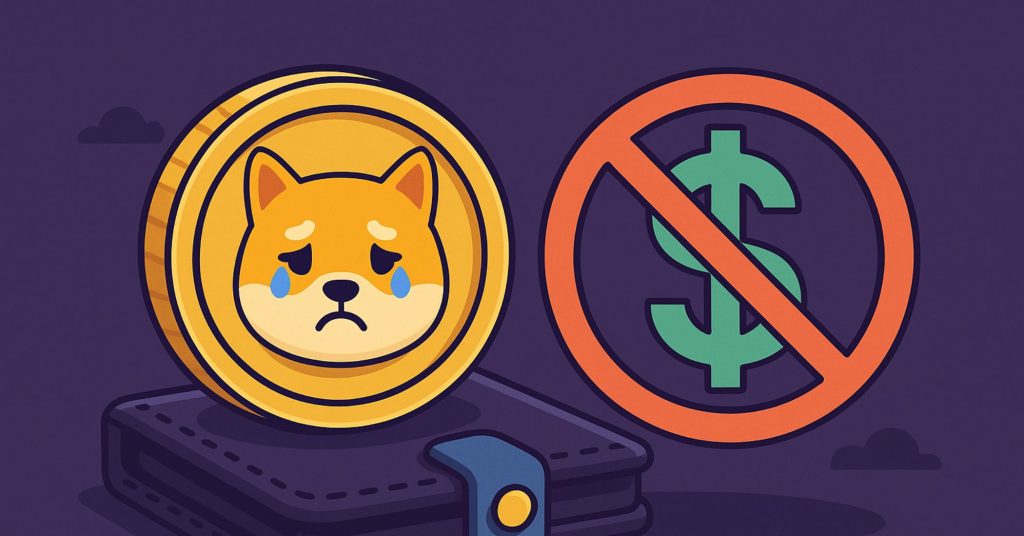But when you try to sell… nothing happens. No transaction. No swap. Just a failed trade and a sinking feeling in your stomach.
Don’t panic, you’re not the first to run into this. A lot of traders, especially in the meme coin space, get caught off guard when a coin can’t be sold. Sometimes it’s a technical issue. Other times, it’s something more shady.
In this post, we’ll walk you through the most common reasons you can’t sell your meme coin, how to check what’s going on, and what to look for next time before you click “buy.”
Want to understand the risks better? Start with the most common crypto scams to avoid.
You Might Be Stuck in a Honeypot
A honeypot sounds sweet, but in crypto, it’s a trap. These are tokens you can buy without a problem, but when you try to sell, it just doesn’t work. The smart contract is set up to block sell orders, and you’re left holding a bag you can’t get rid of.
These types of coins often pop up out of nowhere, launch with lots of hype, and promise fast gains. But behind the scenes, the contract is coded to let you in, not out.
How to check for it:
- Use a scanner like Token Sniffer to review the contract
- Look for recent trades on the blockchain, is anyone actually selling?
- If you’re unsure, ask in a trusted crypto community before buying
If you’re unsure whether you’re in one, here’s how to check if a meme coin is legit before you buy.
Liquidity Might Be Too Low (or Gone)
To sell a coin, there needs to be enough liquidity, which means enough of the token and a base coin (like ETH or BNB) locked in a pool so trades can happen. If the project never added enough liquidity, or if the liquidity was pulled, your token becomes worthless in practice.
This is very common in short-lived meme coins. The devs pump the price, then yank the liquidity and disappear.
What you can do:
- Check the token’s liquidity pool on a site like DexTools or PooCoin
- If the pool size is tiny or zero, there’s no way to trade
- Always look for projects that lock liquidity for a fixed time
No liquidity means no buyers. Even if the price chart looks great, you can’t sell if there’s nothing on the other side of the trade.
The Token Might Be Blacklisting or Taxing You
Some Solana meme coins are built with shady mechanics baked into the contract. One trick is wallet blacklisting, where certain users get blocked from selling. Others slap you with crazy high taxes the second you try to make a trade, sometimes you lose nearly everything in one move.
If you’re diving into Solana meme coins, it’s even more important to read the fine print. Not every contract is created with good intentions.
The worst part? These setups often aren’t obvious. Many of these coins launch with cool branding and hype, but the contract tells a different story.
What to watch for:
- Tokens with no GitHub, no dev info, and no community discussion
- Contracts that allow the owner to change sell rules after launch
- Charts where you see only green candles and no one selling
If a coin looks too perfect, it might be designed to trap buyers with no real exit.
You’re Not Using the Right Network or Settings
Solana is fast and cheap, but it still has its quirks. If you’re trying to sell a meme coin and nothing’s happening, it might be a simple issue like using the wrong wallet, being on the wrong RPC, or not adjusting slippage correctly.
Best slippage for meme coins varies by project, and not setting it right can make or break your trade.
How to troubleshoot:
- Make sure you’re using a Solana wallet like Phantom or Backpack
- Try swapping through a trusted aggregator like Jupiter
- Look on X (Twitter) or the coin’s Telegram for exact sell instructions
Sometimes it’s not a scam, it’s just Solana being picky. But always double-check, especially with meme coins that launched recently.
It Was a Scam All Along
Sometimes the harsh truth is… you got rugged. The coin was never meant to be legit. It was built fast, launched with hype, pumped for a few hours, then vanished with everyone’s money.
This is common on Solana right now because launching a token is cheap and easy. Scammers take advantage of that by creating meme coins with no real team, no plan, and no intention of sticking around. The goal is to collect your SOL, then disappear.
You’ll know it’s a scam when:
- The website goes offline right after launch
- The Twitter account stops posting
- The dev wallet drains the liquidity pool
- There’s no real trading volume left
If you can’t sell, there’s no liquidity, and the devs are gone, the project is likely dead. It happens fast, and it sucks, but it’s also a big part of why meme coin trading needs extra caution.
Not sure how to spot the warning signs? Learn how to snipe meme coins safely, without falling into a trap.
Conclusion
Not being able to sell a meme coin is one of the most frustrating things in crypto. Sometimes it’s a technical issue. Other times, it’s a full-on scam. In the world of Solana meme coins, things move fast and not always in your favor.
The good news? You can avoid most of these traps by slowing down, doing a little research, and knowing what to look for. Always check the contract, look for real liquidity, and make sure people are actually able to trade the coin.
If something feels off, it probably is. Stick with trusted meme coin trading platforms, learn from each trade, and never invest more than you’re willing to lose.









